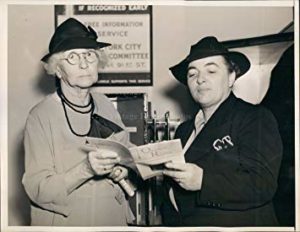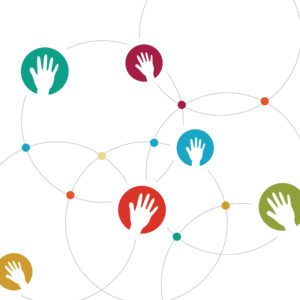
Marjorie Illig (right) in 1938
Marjorie G. Illig is one of my heroes. In 1936, 20 odd years after the American Cancer Society started as a tiny group of volunteers, she amassed a volunteer army of female volunteers to knock on doors across the country and start a conversation at kitchen tables. By 1945, the American Cancer Society, funded by Mary Lasker, a volunteer, and others, had raised $4 million dollars.
Very little of its first 30 years were driven by staff. They accomplished all of that from tiny rooms, the back of cars and living rooms.
In fact, in the heyday of the 80s and 90s, nonprofits rode the rising tide of wealth in our nation. We shifted from volunteer-led organizations to staff-run and created organizational structures.
In 2008, the markets crashed. Money got tight. People lost their homes. People lost their jobs. As a direct result, nonprofits lost a substantial part of their funding. In that moment, we all understood the value of the volunteer.
2008 forced many of us back to our roots, and our roots weren’t a bad place to be. The value of the volunteer wasn’t just free labor, it was and still is the vital energy, direction and capital for organizations doing good work.
Retaining Volunteers is Tricky
It is hard to retain volunteers. We ask them to give their time, their talent, and often, their treasure. When we do it incorrectly, we lose big and our missions suffer. According to the Stanford Social Innovation Review, ineffective volunteer management can result in more than one-third of those who volunteer one year to not donate their time the next year, which is an estimated $38 billion in lost labor.
Traditional volunteering relies on volunteers to do the grunt work. It’s like going to a job. You clock in, you clock out. You follow policies and procedures to deliver some kind of service. Think about Illig’s army. They went door to door with talking points and leaflets.
This type of volunteering appeals to a certain group of people. There are lots of volunteers who like to work at hospitals, museums, animal shelters, etc. It doesn’t appeal to everyone, especially volunteers still in the workforce. Our challenge is to meet the diverse volunteer needs within our organization.
Beyond Candy Stripers
When we get it right though, our organizations shine. What do we know about volunteers? They need meaningful engaging work that meets their skillset and helps them grow as a person and, often, as a professional. Finding the exact right fit for volunteers lets them give back and keeps them coming back year to year to move your mission forward.
Volunteers can fill roles across our organizations that staff are currently filling. This means we need to look very closely at what our staff are doing and ask, “how can a volunteer partner with them?” This means using volunteers in different ways and understanding that each role needs a different type of volunteer. When we do so, we bust the doors wide open to long term volunteer engagement.
The Value of Volunteers as Leaders
Someone emails you. You can tell they have a clear vision and are accountable, responsible, used to making decisions that have a deep impact, a planner, an organizer, and an innovator. You look at your list of open opportunities and say, “well, you can walk a dog.” They do it for a couple of months and leave. You didn’t meet their skills and capabilities head on.
Governance roles are perfect for your independent volunteers. It lets them be who they are, and it uses their brain in a way that motivates them. It gives them a challenge to master. This is the volunteer you want on your board or committee, as a chairperson or as a volunteer manager.
The Value of Volunteers as Drivers of Social Change
A person walks into your library on a Saturday. They are passionate about equal access to education and thrive on having conversations with people about the structural changes to enable reading development and early childhood education. All volunteers do at your library is shelve and dust books. The volunteer says, “sure,” and never follows up.
Social Action Volunteers allows you to harness that person’s passion and drive change that moves your mission forward. This type of volunteer is the person who will attend protests, send letters/postcards to legislators or go in person to lobby. Once a match is made, they will move mountains to get in front of the people who need to listen to them.
The Value of Volunteers as a Skills-Based Volunteer Force
Traditionally, skills-based volunteers donate their skills on an ongoing basis over long periods of time. Think pro-bono lawyers, doctors, nurses, accountants and grant writers who help organizations they care about year to year. They typically find us and know which organizations they can and want to volunteer with.
They are vital to delivering front-end service. We can tap into their need to give back and supercharge our service output, as long as the role is clear.
The Changing Shape of Skills-Based Volunteering
Young volunteers want to work on projects and make their contribution matter to an organization. They may not know where they will be living next year or what their life will look like, but they know you need the skills they have to offer. These volunteers don’t even get in your door right now, unless you have project-based volunteer opportunities listed. You didn’t even get to talk to them.
Today, when every job you try to get, you need three to five years of experience, a masters and be willing to accept an entry-level salary, young workers are looking for ways to gain skills and feed their need to give back. Projects that are time-limited give them just that.
When we have projects that allow them to commit to a short period of time and drive their personal growth and development, they will come back again and again to help. If we give them projects that allow them to give back in the short term, but don’t lead to personal growth, we aren’t tapping both motivations.
 Volunteers are Valuable, so What?
Volunteers are Valuable, so What?
2008 was a watershed moment for all nonprofits. It forced all of us to reckon with who we as organizations had become, and it reminded us that we all started as a group of volunteers in some poorly lit room drinking bad coffee planning to change the world. I know I did, and the organizations I love all did.
American Cancer Society took Relay For Life back to its roots. In its first year, the organization saw 200 DIY Relay events that helped raise over $2 million in unbudgeted revenue. Illig, with her volunteer field army, would be proud.
People are ready to be valued volunteers. The real question is, are you ready for them?

 Volunteers are Valuable, so What?
Volunteers are Valuable, so What?